Related page
I joined the BBC as a TO (Technical Operator) in London Control Room in the autumn of 1959 and was lucky to see a building little changed since the 2nd World War and still reflecting radio in its first golden age, before the growth of television. There had been chronic shortages in the immediate post war years, followed by the rapid expansion of television and the consolidation of external services at Bush. Now the modernisation of BH was to follow and work had started on building the extension which was to contain many new studios and a new control room and continuities.
The Sub-Basement
Related page
On the other side of the corridor are S2 and S3, best described as "engineering mixers". No separate studios, just multi source OBA/8 type mixers with a bank of TD/7 grams and a table for an announcer. I can't remember S2 being seriously used but S3 had had a bank of type B clean feed amps added and was still used for multi lateral "Radio Link" discussion programmes with the London contributors in another BH studio.
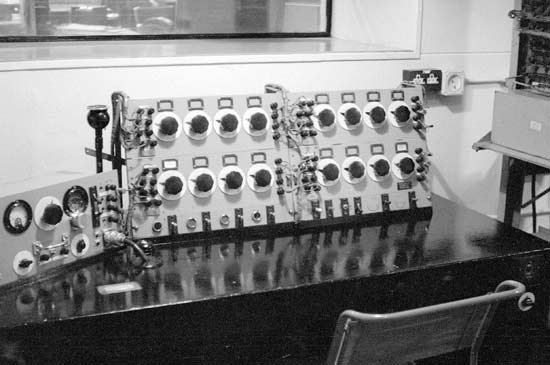
S2 - The SM's desk. London Control Room is beyond the window.
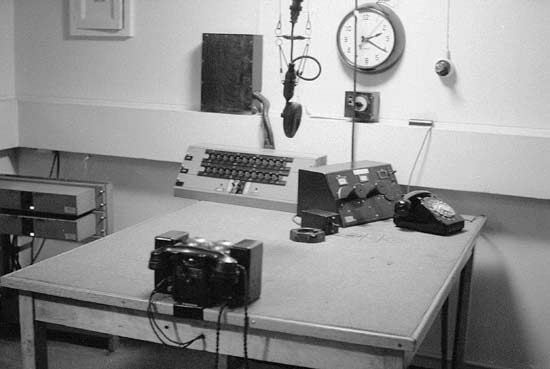 |
S2 - The announcer's desk. (The PABX telephones in
this picture and the one below were not present in 1959)
|
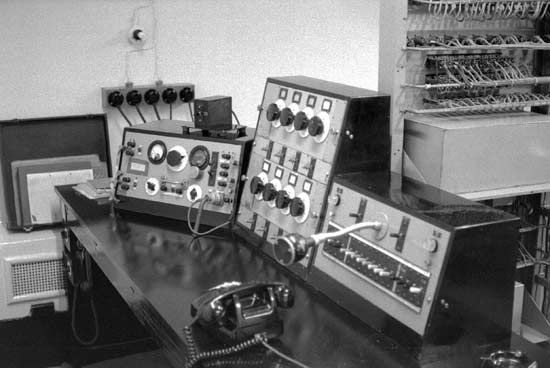
S3 - The SM's desk. The rear of the TO desk is to the upper right.
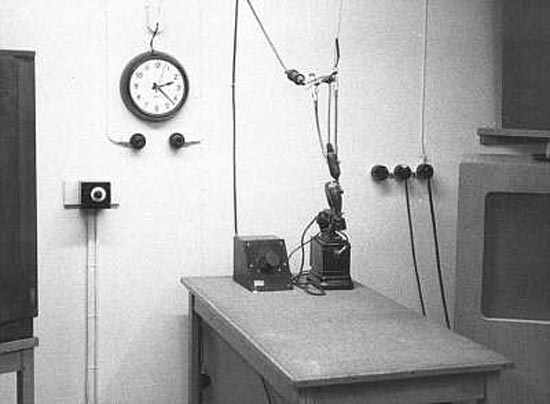 |
S3 - The announcer's table.
|
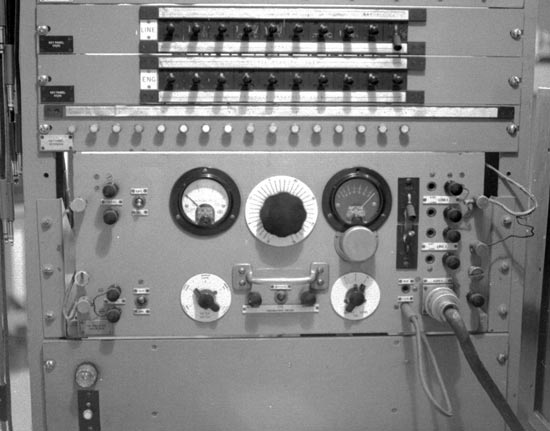
S3 - A part of the T.O.'s position.
(below) S3 - TD/7s.
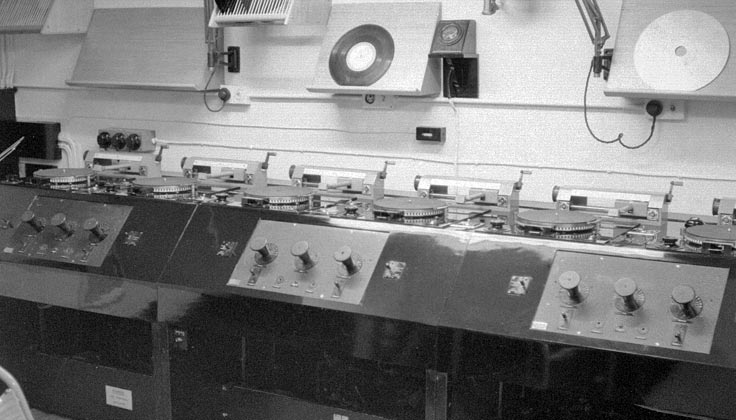

At the front of the building (under reception but still two floors down) are H5, a disk recording channel fitted with BBC designed gear (Type D) and the diminutive talks studio B5 with a Marconi desk and some grams.
Moving round the Portland Place side of the building past the battery room, we come to B1.

This is either a spare continuity similar to the others or an amazing giant mixer! The studio not only contains a standard announcers desk with its two grams but a Type B desk with 4 normal channels and 6 channels each switchable on the fader panel to one of 4 outside sources. Selection is indicated by coloured lights also on the fader panel and with the fader open, relays on the fader back stop allow you to preselect the next source. There is a large panel of Prefade/talkback keys and telephone ring and answer keys. There's no studio talkback, though, as the announcer sits next to the producer with a lip mic. Sources are plugged up on an extended jackfield on the continuity bay which becomes a "TO position".
This is also one of only two studios with a TV set (the other being 4A) and it's an off-air projection model at that but you can't get ITV on it. Unfortunately B1 is flawed in that there is no means of cutting cue from control lines temporarily in use elsewhere, nor can it handle separate cue lines.
Next door, Light Con, currently on air from 0630 till midnight, is much the same as the others and then comes tiny B2 with an OBA/8 (or perhaps it was a Marconi) and next to that an area known as RM4. The name - Reproducing Mixer - is a hang over from an older way of working and this is a small Type B with comprehensive grams which "shares" B2's studio.
The canteen occupies the corner of the building but let's resist the tempting smell of boiled cabbage and head back to the front of BH and up to lower ground where we find L1 - "The VIP studio". A standard small Type B in the cubicle but a talks studio decked out with Swedish glassware and fancy tables and chairs.
Through the tunnel under Langham Street now to Egton House, the home of News Division.
Radio Newsreel
For younger 21st century readers, I should explain that our tour is taking place before the BBC became obsessed with news and the current form of a news bulletin is a 15 minute straight read by an unidentified announcer. "Today" exists as a "magazine programme" but the only programme similar to a modern news is Radio Newsreel (usually abbreviated to RNR) which has 5 or 6 overseas editions and a 25 minute Light programme slot at 1900.
Immediately beyond the tunnel lies H6 the news recording channel. It's actually 3 channels, one behind the other, each contains a pair of American Presto disk recording machines. The swarf from the disks is highly inflammable so this is one of the few smoke free areas in the building, much to my relief as a non smoker. The front channel has a window into the cubicle of L2, the RNR studio and a hatch through which last minute disks can be passed. There is a pair of BTR/2 tape machines under the window but these are only used to back up disk recording or copy tapes from reporters' EMI "Midgets" to disk. Tapes are not played on air.
Beyond L2 is a small courtyard leading to a cluster of recording/editing channels, each with 2 or 3 "Green Goddess" BTR/2s. We are now in the building next door to Egton, known as Cavendish Mansions. But back in Egton there are 3 more studios, all small Type A's, named as if they are in BH. 1A is used for grams shows, 3G is the main news studio and 3F is its back up, otherwise used for talks.
BH above Ground
Most of the brick tower that forms the core of BH is taken up from LG to first floor by the Concert Hall (Type A desk) and then follows a layer of offices to act as sound insulation before more studios on the 3rd floor. Unfortunately, the concert hall organ is clearly audible in all the 3rd floor studios and beyond.
The largest 3rd floor studio is 3A, double height with the cubicle looking down on it from the 4th floor; it's still used for Children's Hour. The large steel cupboard containing the Type A amplifiers is in a small room next to the studio. This also carries the jackfield so any replugging involves the SM in a lengthy journey along the corridor and down the stairs.
Opposite 3A is a group of small talks studios 3B, 3C and 3D, all equipped with Marconi desks. Work is soon to start on knocking 3B and 3C together to make a new larger 3C. A new 3B will be built outside the tower in office space at the back of BH, along with a news recording channel to replace H6. Both these new studios will have Type B desks and 4 Philips tape machines built into a bench.
At the end of the corridor is 3E which was originally decorated as a chapel, complete with stained glass "window" and pulpit. A hymn book rack behind the curtaining is all that is left to remind us of its former glory.
Moving up a floor, we come to 4A, a medium sized talks studio with a large type A desk which has 7 outside sources, the last three being on an added panel. This is the home of Sports Report. There is a good collection of grams as the Sunday lunchtime "Two way Family Favourites" also comes from here. This still gets 12 million listeners as there is no TV on the air at the time.
Opposite 4A is 3A's cubicle and a small tied "narrators studio", harking back to the days when, if you wanted a different acoustic, you used a different studio.
The 5th floor of the tower is the recorded programmes library and on the 6th floor, a large drama studio, 6A. Again the studio is double height and the cubicle with a large Type A is on the 7th floor. 6A also has a separate narrators studio. There is no 6B, but 6C is a largish talks studio with a small Type A cubicle. Incidentally, 6A is the only cubicle without a PBX phone, although there is one out in the corridor. Like all the original studios, apart from the Concert Hall, it is very functional and it's only in those tower corridors that you get a flavour of the original Art Deco
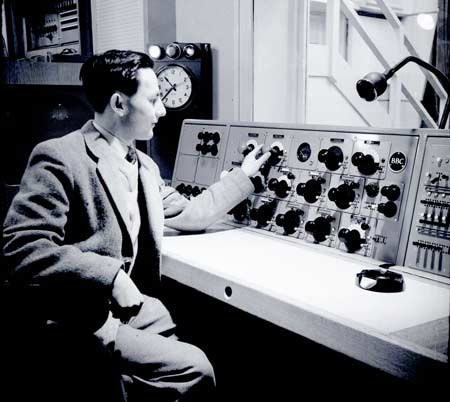
The author in 8A, c.1959
On the 8th floor there is no longer room for the tower so 8A is on the Portland Place side of the building. It was originally used for brass bands and the like but is now a drama studio. The cubicle, like most is quite small and the two group Type B desk is mounted on a dais to provide a better view of the studio.
Related page
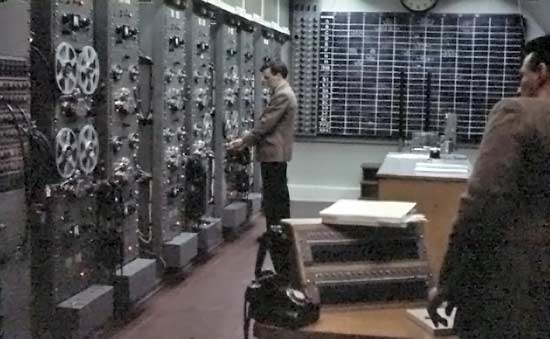
Why not choose 8 studios and put a pair of trolley mounted machines in each? Well there are a few TR90s trundled around the building with their valves rattling for really complicated shows but they are operated by TOs not SMs because recording is an engineering function and it will be 1967 before those Philips machines about to go into 3B are fully utilised.
The age of direct disk recording is drawing to a close. Tape and razor blades now rule and it will be 35 years before I "cut" my next disk on D-Cart at Millbank.
Some memories
One pair of machines in H12 had a key that worryingly seemed to switch the machine into record! In fact what it did was to apply a very low level erase voltage which was supposed to reduce print through. Whether this worked or not I don't know but I remember a trainee operating the key saying "What's this do?" and looking aghast as the red record lamp lit. However it made no audible difference to the output much to his (and my) relief! - Barry Taylor
There were two very large toilets on the LG and Basement, one gents and one ladies. On an old pre-war fire plan I once saw these were labelled "Junior Male and Junior Female Staff Toilets". This implies that if you were a junior oik you had to go all the way down to the bottom of the building for a pee! I suppose the small toilets on each floor were executives only! - Barry Taylor
Jargon
DX689 was a line between Broadcasting House in
London and Daventry, DX being the BBC's abbreviation for the latter. At
this time the Post Office controlled telecommunications infrastructure
and would have known this line as PW12689, PW meaning 'Private Wire'.

